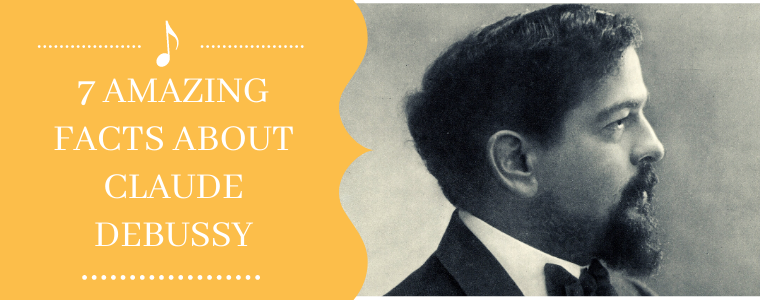
Claude Debussy is a famous French composer, well-known for works such as Clair de Lune (Moonlight) and Prélude à l'Après-Midi d'un Faune (Prelude to the Afternoon of a Faun). A quick listen to either of those works is an aural reminder of Debussy’s position in the Romantic music era. That said, his life ended during the post-Romantic period (Debussy lived from 1862-1918), which is part of what makes his compositions so interesting.
While Debussy’s feet and sentiments were rooted in the Romantic music period, his full body of works are also known for their impressionist and symbolic ideals that were influenced by famous artists and writers of the time. Click here to review a complete list of Claude Debussy’s compositions.
Compelling Facts Worth Knowing About Claude Debussy
Although Claude Debussy didn’t make our 10 Romantic Composers You Need to Know List, we thought it worthwhile to feature him and share seven compelling facts worth knowing about one of the classical music world’s most celebrated composers.
1. He didn’t grow up in a musical family
The Mozarts, Beethovens, and Mendolssohns are all examples of legendary and multigenerational, classical music dynasties. Unlike the children in those families, who grew up with musicianship as a focal point in their lives, Debussy grew up in a poor, working-class family. His mother was a seamstress and his father owned a china shop. Claude Debussy’s passion and skill for music, however, was undeniable and the family made the sacrifices necessary to start him in piano lessons when he was seven years old.
2. Debussy’s musical genius was undeniable
Within three years of starting on the piano, there was no denying Debussy’s musical genius. As a result, he was accepted into the Paris Conservatory, where he studied music and composition for the next 11 years.
3. Performance failure spurned his dedication to composition
We are big believers in the idea that failures are inevitable and should be viewed as an opportunity for learning. Debussy could be a mascot of that concept because his own failure to win the Paris Conservatory’s Premier Prix for piano performance (a high honor Diploma of Musical Studies) led him to abandon his dream of being a piano virtuoso in order to focus his talents and energy on composition.
4. He won a scholarship to L’Académie des Beaux-Arts in the Villa Medici
More proof that your losses in life can propel you to greater wins is exemplified in Debussy’s 1885 winning of the Prix de Rome (just shy of age 23). That win helped to earn him a four year scholarship at L’Académie des Beaux-Arts in the Villa Medici.
5. He challenged traditional views of instruments’ roles in the orchestra
Perhaps one of the most comprehensive musical influences Debussy initiated was how instrumental roles were viewed in the orchestra. According to Britannica.com, Debussy, “...rejected the traditional dictum that string instruments should be predominantly lyrical,” or, “...that woodwinds need not be employed for fireworks displays…” He saw these instruments as capable of depicting much wider varieties of color, tone, texture, and intimate vocalizations, and structured his use of them accordingly.
6. “Chouchou” (his only child and daughter) was the exception to a womanizer’s rule
Like many musicians, Claude Debussy was a passionate man. So passionate, in fact, that author and biographer Marcel Dietschy wrote, “There was a woman at each crossroad of Debussy’s life. Certainly, women of all ages seemed fascinated by him, and they attached themselves to him like ivy to a wall.”
Between the years 1890 to 1904, Debussy lived with and/or married three different women, in addition to other extramarital affairs. There was one female love of his life, however, and that was his only child, daughter Claude-Emma Debussy, who was affectionately nicknamed “Chouchou.” Debussy was devoted to Chouchou and dedicated two works to her, the piano works titled, Children’s Corner, and the children’s ballet, La Boîte à Bijoux.
7. Debussy had an alter-ego, Monsieur Croche
We are fascinated by the fact that Claude Debussy had an active alter-ego, one that he named, “Monsieur Croche.” This alter-ego was a role he took on to explore imaginary conversations about art, nature, and other soulful and spiritual topics. Originally established as a nom de plume when he worked as a music critic for an art and literary magazine called La Revue blanche. Within a short time, the nom de plume became an alter-ego, and The Essays of Monsieur Croche were collected and published three years later.
Alter-egos can be helpful for string musicians and performers, helping to develop an on-stage persona that remains separate from your private and personal life.
Interested in getting to know Debussy from a more musical perspective? Click here to begin working on a violin solo for Clair de Lune, or here for a violin duet.

